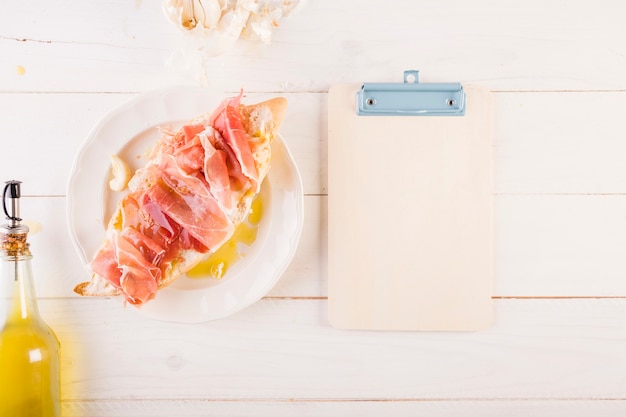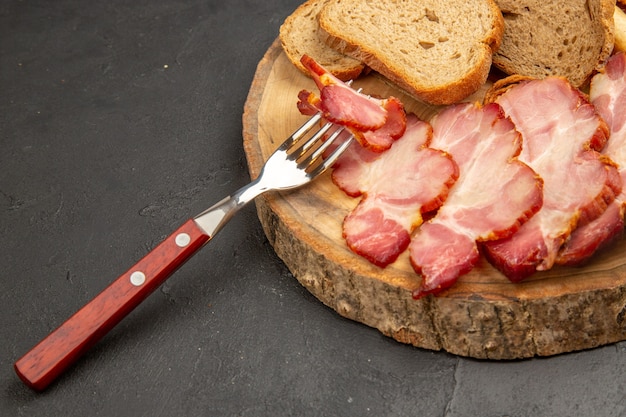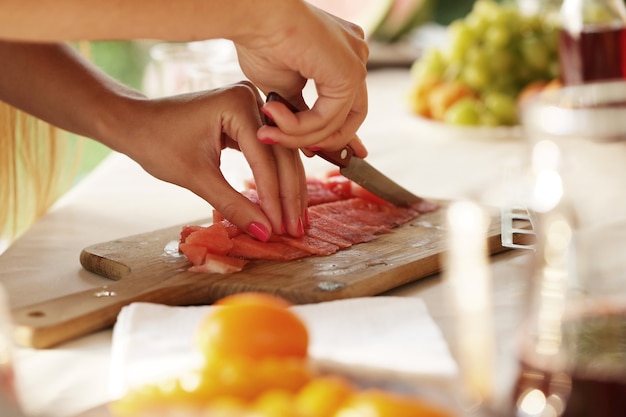Let's be honest, folks, bacon isn't just breakfast food – it's a culinary symphony of pure, unadulterated deliciousness. It's a symbol of crispy, salty, smoky perfection that deserves the utmost respect. But achieving that perfect crisp, that golden-brown magic, isn't always a walk in the park. There's an art to it, a delicate dance between heat, time, and a whole lot of love.
And today, I'm going to share my secrets, my hard-earned wisdom, to help you conquer the bacon battlefield and emerge victorious with a plate of crispy perfection. We'll explore the different types of bacon, dive into the best cooking tools, master the art of frying and baking, and even learn how to elevate your bacon to new heights with flavour and texture.
(Part 1) The Great Bacon Debate: Choosing Your Weapon

Firstly, let's talk about the bacon itself. The world of bacon is a vast and delicious landscape, offering a variety of choices to satisfy every palate. You've got your thick-cut, your smoked, your streaky, your back bacon – the choices are endless! But trust me, each type has its own personality, its own strengths and weaknesses, and understanding them is key to cooking the perfect batch.
The Thick-Cut Champion
thick-cut bacon is my personal favourite. Those generous slices offer a beautiful, meaty bite, and they hold their shape perfectly when cooking, ensuring even crisping. The thick cut also means you get a more satisfying chew. But be warned, it takes a bit longer to cook and requires a bit more attention than thinner cuts. It's like a slow-burning flame, requiring patience and care.
The Smoked Masterpiece
smoked bacon, with its rich, smoky flavour, brings a whole new dimension to the game. The flavour is incredible, adding an extra layer of depth to the bacon experience. However, be careful not to overcook it, as the smoke can become overpowering and mask the bacon's natural flavour. It's like a delicate spice that needs careful handling.
The Streaky Rebel
streaky bacon, oh, the classic! It's thin, it's salty, it cooks quickly, and it's perfect for a quick breakfast. However, it's also notoriously prone to overcooking, becoming dry and brittle if you're not careful. Think of it as a wild stallion, needing a steady hand to keep it from bolting.
The Back Bacon Enigma
Back bacon, with its leaner profile and distinct flavour, is a bit of an acquired taste. It's more suited to those who appreciate a more delicate flavour, and it cooks up beautifully with a lovely, even texture. Imagine it as a quiet, refined gentleman, needing a touch of elegance.
(Part 2) The Battlefield: Your Cooking Tools

Now, onto the battlefield. We're talking about your trusty frying pan, your oven, and any other tools that can help you achieve bacon bliss. The wrong tools can lead to a culinary disaster, so choose wisely!
The Frying Pan: Your Primary Weapon
A good, heavy-bottomed frying pan is your best friend when it comes to frying bacon. Cast iron is the gold standard, distributing heat evenly and creating that beautiful sear. Its durability and ability to retain heat make it ideal for achieving perfect crispness. However, stainless steel is a decent alternative if you're looking for something lighter.
A non-stick pan can work, but be careful as it can make it harder to achieve that perfect crisp due to its slick surface. Also, make sure it's oven-safe if you plan on using it in the oven.
The Oven: Your Secret Weapon
The oven is a great option for a large batch of bacon, especially if you're feeling lazy. It allows for even cooking and requires minimal effort. Simply place the bacon on a baking sheet and let the oven do its magic. Just be sure to keep an eye on it, as ovens can be a bit fickle, and you don't want to end up with burnt bacon.
The Other Players
There are other tools that can come in handy, like a baking sheet, a wire rack, and even a splatter screen. These tools can help you achieve better results and keep your kitchen clean. A wire rack placed over a baking sheet allows air to circulate around the bacon, resulting in even crisping and less grease. A splatter screen prevents grease from splattering everywhere, saving you time and effort when cleaning. They're like the supporting actors, making your bacon shine.
(Part 3) The Art of Bacon: cooking techniques

Here we are, the heart of the matter. This is where the real magic happens, the moment your raw bacon transforms into a symphony of crispy perfection.
Frying Pan Technique: The Classic
The frying pan method is the most common and, in my opinion, the most rewarding. You get that beautiful sizzle, that enticing aroma, and the satisfying crispness. It's like a dance of heat, fat, and flavour.
- Heat: Medium heat is your friend. Too high and the bacon will burn before it crisps, leaving you with burnt edges and an unpleasant smoky flavour. Too low and it'll take forever and end up soggy, lacking that desired crunch.
- Placement: Don't overcrowd the pan. Give each slice room to breathe. Overcrowding will lead to uneven cooking and prevent the bacon from crisping properly. It's like giving them space to shine.
- Flipping: Flip the bacon when it's golden brown on the bottom, about 2-3 minutes. This allows for even crisping on both sides. Keep a close eye on the bacon as it cooks, as the timing can vary depending on the thickness and type of bacon.
- Crispness: Continue cooking until the bacon is crispy to your liking. You'll know it's ready when it's firm and has a slight curl. If you like it extra crispy, you can cook it for a few more minutes until it becomes brittle.
Oven Technique: The Lazy Option
The oven technique is perfect for large batches or if you're just feeling lazy. It's like a set-it-and-forget-it approach to bacon cooking.
- Preheat: Preheat your oven to 400 degrees Fahrenheit (200 degrees Celsius).
- Arrangement: Place the bacon on a baking sheet lined with parchment paper, making sure the slices don't overlap. This prevents sticking and ensures even cooking.
- Cook Time: Bake for about 15-20 minutes, or until crispy. Keep an eye on the bacon, as the cooking time can vary depending on the thickness and type of bacon.
(Part 4) The Bacon Spectrum: Levels of Crispness
We all have our preferences when it comes to bacon crispness. Some like it soft, some like it chewy, and some like it so crispy it crumbles in your mouth. It's like a spectrum of textures, a journey of culinary satisfaction.
Soft and Supple
This level of crispness is for those who prefer a softer bite. It's still cooked, but it retains a bit of its chewiness. It's like a gentle caress, a subtle nudge of flavour. This is perfect for those who enjoy a more tender bacon texture.
Chewy and Juicy
This level is for those who enjoy a bit more bite. The bacon is crispy around the edges, but retains its juiciness in the centre. It's like a balancing act, a harmony of textures. This is ideal for those who want a combination of crispness and tenderness.
Crispy and Crunchy
Ah, the holy grail of bacon crispness. This is where the bacon reaches its peak of perfection. It's golden brown, crunchy, and incredibly satisfying. It's like a symphony of crackling, a celebration of flavour. This is the classic bacon experience, offering a satisfying crunch with every bite.
Crispy and Crumbly
This is the ultimate level of crispness, where the bacon is so crispy it crumbles in your mouth. It's like a delicious explosion of flavour, a textural masterpiece. This level of crispness is for the true bacon enthusiasts, those who crave that intense, crunchy experience.
(Part 5) The Final Touches: Adding Flavor and Texture
Now, we're getting into the fine art of bacon. It's not just about the crispness, it's about adding those extra touches of flavour and texture that elevate your bacon to a whole new level.
Sweet and Smoky
Maple syrup is a classic pairing for bacon, adding a touch of sweetness and complexity. A sprinkle of brown sugar or a drizzle of honey can also work wonders. The sweetness balances the saltiness and smokiness of the bacon, creating a truly harmonious flavour profile. It's like a sweet melody complementing the smoky base notes.
Spicy and Savory
For those who like a bit of heat, a sprinkle of cayenne pepper or paprika can add a kick. A dash of garlic powder or onion powder can also enhance the savory flavour. These spices add a vibrant dimension to the bacon, creating a more complex and exciting taste. It's like adding a spicy drum solo to the bacon orchestra.
Herb and Spice
A sprinkle of herbs like rosemary, thyme, or sage can add a touch of freshness and complexity. A pinch of cumin or coriander can add an earthy dimension. These herbs and spices introduce a whole new range of aromas and flavours, making your bacon more interesting and captivating. It's like adding a floral arrangement to the bacon tableau.
(Part 6) The Aftermath: Storing and Serving Your Bacon Triumph
Your bacon is cooked to perfection. The crisp is perfect, the aroma intoxicating, the taste divine. But now, what do you do with this masterpiece?
Storing Your Treasure
If you're not devouring it immediately, store it in an airtight container at room temperature for up to a week. However, for the best flavour and texture, it's best to consume it within a few days. It's like keeping a precious jewel safe and sound, but it's best to admire it while it's still at its peak.
Serving Your Creation
Bacon is incredibly versatile, a canvas for endless culinary creativity. Serve it in a classic breakfast sandwich, add it to a salad for a salty crunch, or crumble it over pasta for an umami boost. It's like a chameleon, adapting to any culinary situation and elevating the dish to new heights.
(Part 7) Beyond the Basics: Bacon Inspiration
Bacon is more than just a food, it's a muse, an inspiration for culinary adventures. Here are some ideas to spark your bacon imagination.
Bacon-Wrapped Delights
Bacon can be used to wrap around almost anything, from chicken and shrimp to dates and asparagus. The bacon adds a smoky, salty flavour and a crispy texture, creating a truly decadent and satisfying dish. It's like a warm hug of savoury goodness.
Bacon-Infused Treats
You can infuse bacon flavour into everything from cocktails and ice cream to cakes and cookies. The bacon fat adds a richness and depth of flavour, transforming ordinary treats into extraordinary experiences. It's like adding a secret ingredient to unlock a whole new world of flavour.
Bacon-Inspired Dishes
From bacon-wrapped jalapeno poppers to bacon mac and cheese, there are endless possibilities for bacon-inspired dishes. These dishes are a testament to the versatility and deliciousness of bacon, a culinary playground where bacon is the star.
(Part 8) The Bacon Commandments: Rules to Live By
As with any great art form, there are certain rules to follow, certain principles to live by. These are the bacon commandments, the guidelines that will help you achieve bacon nirvana.
- Thou shalt not overcrowd the pan. Give the bacon room to breathe and cook evenly.
- Thou shalt not overcook thy bacon. Watch closely and remove it from the heat just before it reaches your desired level of crispness.
- Thou shalt not be afraid to experiment with flavours. Play with spices, herbs, and sweetness to discover new and exciting bacon combinations.
- Thou shalt enjoy thy bacon with a joyful heart. Bacon is a celebration of flavour, a culinary delight to be savored.
FAQs
Q1: Can I reuse bacon grease?
Absolutely! Bacon grease is a culinary goldmine. It adds incredible flavour to everything from scrambled eggs to roasted vegetables. The smoky, salty flavour of bacon grease enhances the taste of your dishes, adding a touch of richness and depth. Just strain it through a cheesecloth or paper towel to remove any solid bits, store it in an airtight container in the fridge, and use it for cooking. Be sure to use it within a few weeks for the best flavour.
Q2: What's the best way to clean a bacon pan?
The best way to clean a bacon pan is to let it cool completely, then wipe out any excess grease with a paper towel. Then, scrub it with hot soapy water, being careful not to use abrasive cleaners that could damage the pan's surface. For stubborn grease, you can soak the pan in hot water with a bit of baking soda.
Q3: How can I make bacon even crispier?
For extra crispy bacon, try baking it on a wire rack placed over a baking sheet. This allows air to circulate around the bacon, resulting in a more evenly cooked and crispy result. You can also try flipping the bacon halfway through the cooking time to ensure even crisping.
Q4: Can I cook bacon in the microwave?
You can, but I wouldn't recommend it. It's unlikely to produce the same level of crispness and flavour as frying or baking. The microwave method often results in uneven cooking and a less appealing texture.
Q5: Is bacon healthy?
Bacon is high in fat and sodium, so it's not exactly a health food. However, it can be part of a balanced diet, consumed in moderation. Just remember to choose lean bacon and avoid overcooking it to reduce the fat content. You can also try alternatives like turkey bacon, which is lower in fat and calories.
There you have it, my friends, the ultimate guide to cooking perfect bacon. Now go forth and conquer the bacon battlefield. May your crisps be perfect, your flavours bold, and your bacon adventures delicious!
Everyone is watching

Prime Rib Roast Cooking Time Chart: Per Pound Guide
Cooking TipsPrime rib roast. Just the name conjures images of lavish dinners, crackling fires, and hearty laughter. It’s ...

How Long to Bake Potatoes in the Oven (Perfect Every Time)
Cooking TipsBaked potatoes are a staple in my kitchen. They're incredibly versatile, delicious, and surprisingly easy to m...

Perfect Rice Every Time: The Ultimate Guide to Cooking Rice
Cooking TipsAs a self-proclaimed foodie, I've always been a bit obsessed with rice. It's the foundation of countless cuisi...

The Ultimate Guide to Cooking Asparagus: Tips, Techniques, and Recipes
Cooking TipsAsparagus. The mere mention of this spring delicacy conjures up images of vibrant green spears, crisp and burs...

Ultimate Guide to Cooking the Perfect Thanksgiving Turkey
Cooking TipsThanksgiving. Just the word conjures up images of overflowing tables laden with delicious food, the scent of r...
